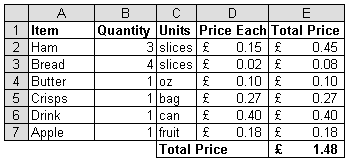| | Spreadsheets : What-If Problems |
|
Spreadsheet models (a type of simulation) can be used to investigate what happens when variables in a model are changed. For example here is a simple model of the cost of producing a packed lunch :

The model uses formulas to calculate the total cost of producing a packed lunch from the individual costs of the items and the quantities required. It could be used to answer questions such as :
| Question | How Answered
| What would happen to the cost of a lunch if the number of slices of
ham required fell to 2.
| The number in cell B2 is changed from 3 to 2.
| What would happen to the cost of a lunch if crisps rose in price from
27p to 29p ?
| The number in cell D5 is changed from £0.27 to £0.29.
| What would happen to the cost of a lunch if an apple was no longer required ?
| The number in cell B7 is changed from 1 to 0 or row 7 is deleted.
| |
Because the values in column E are calculated using formulas when the values typed into the spreadsheet are changed the totals are automatically recalculated. It is for this reason that spreadsheets are often used to answer "what-would-happen-if" (or "what-if") problems. Once the formulas have been created, the effects of changing values can be determined easily and quickly.
Spreadsheets can be used to answer much more complicated questions. Typical "what-if" problems could be :
1.
| What would happen to the school tuck shop's profits if the cost of buying sweets rises by 10%?
|
| 2.
| If a company made two workers redundant, what would happen to the company's
wage bill and profits?
|
| 3.
| What would be the effect on an airline's profit if the number of passengers flying
with it rose by 50% as a result of a 15% reduction in ticket fares ?
|
| 4.
| What would be the effect on the economy of a 1% rise in the interest rate ?
| |
GCSE ICT Companion 04 - (C) P Meakin 2004